The brown roll rim mushroom (Paxillus involutus) is a funnel-shaped mushroom with edges that are very tucked under. This is a very common mushroom in northern North America, and it has a very distinctive look. The brown roll rim was once considered edible. But there have been several fatalities from eating this species, so be careful! Despite it’s toxicity, it is currently being investigated for potential medicinal properties.
- Scientific Name: Paxillus involutus
- Common Names: Brown roll-rim, Common roll-rim, Poison paxillus, Naked brimcap, Inrolled pax, Poison pax, Brown chanterelle
- Habitat: On the ground in association with birch, spruce, pine, and oak, among otheres
- Edibility: Poisonous, potentially fatal
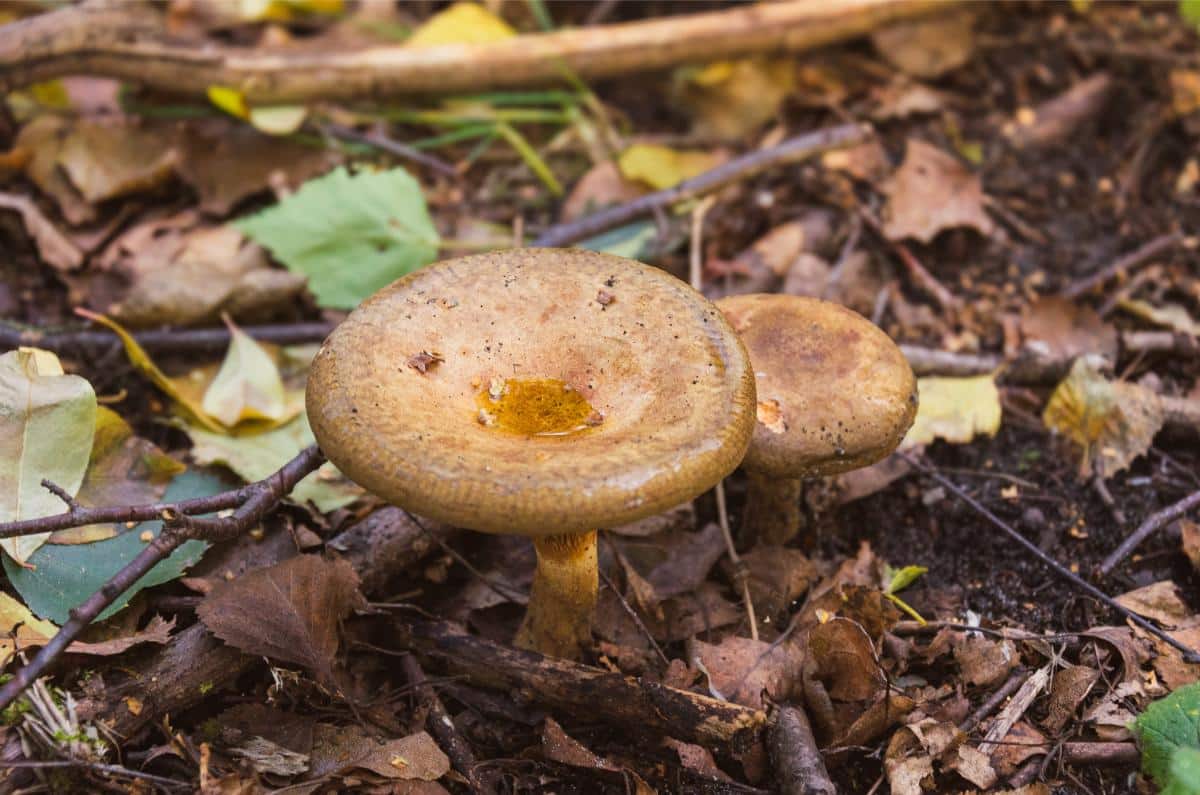
Jump to:
All About The Brown Roll Rim Mushroom
The brown roll rim mushroom is part of the order Boletales. This is a little bit odd since most Boletales have pores under their caps, not gills. In this situation, though, the brown roll rim shares more features with Boletales than other gilled mushrooms. The scientific name for the brown roll rim mushroom, “Paxillus,” is Latin and means small stake or peg. This refers to the overall shape of the mushroom, which resembles a peg. The name “Involutus” describes the inrolled cap edge, the mushroom’s big standout feature.
There are tons of different names for this mushroom depending on where you live. The most common English names include brown roll-rim, common roll-rim, poison paxillus, naked brimcap, inrolled pax, poison pax, and brown chanterelle. One of the best historical names was given by Samuel Frederick Gray. He called it the “involved navel-stool” in his 1821 book on British flora.
Genetic studies suggest that what we call Paxillus involutus is actually a complex of multiple, similar-looking species rather than a single one. In a study from Sweden, done from 1981 to 1983, mycologist Nils Fries discovered that there were three groups of P. involutus that could not breed with each other. This suggests they are different species, and there were suggestions of splitting the species up because of this. However, besides the inability to reproduce with each other and other very small and variable differences, it is very hard to differentiate them.
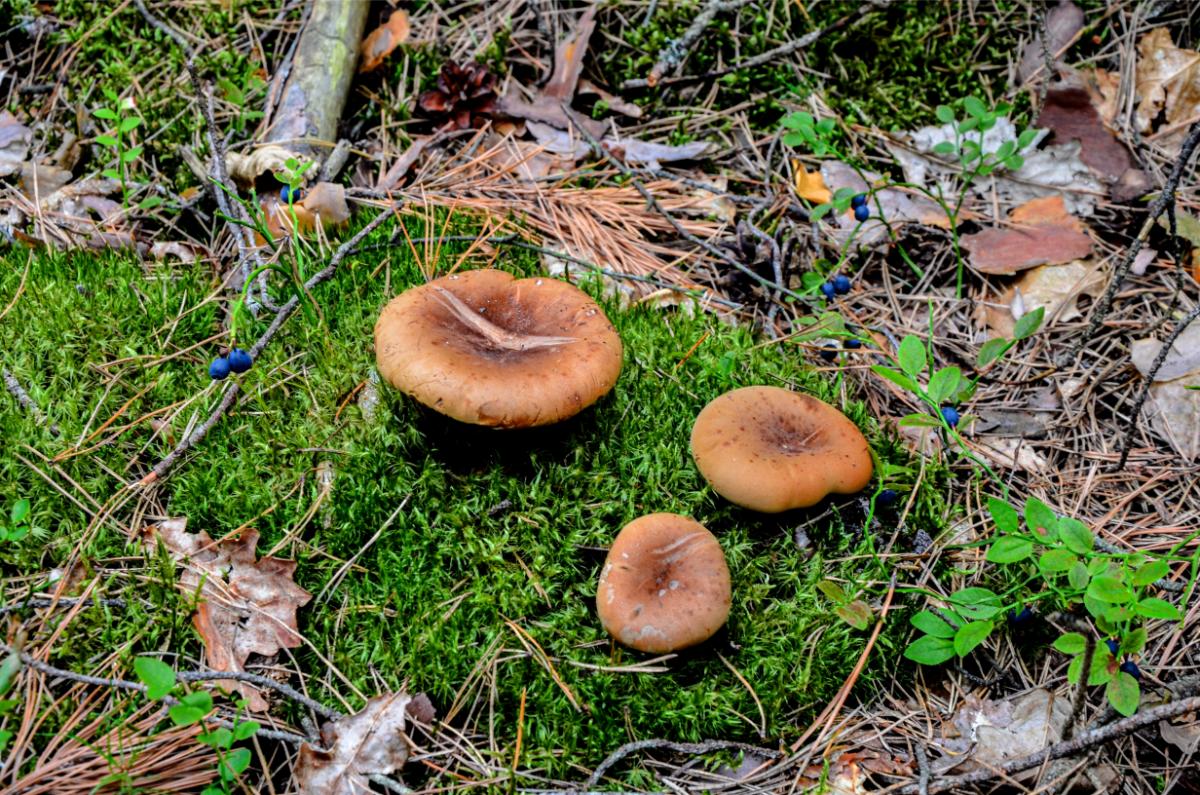
One group was found under conifer trees and mixed woodlands, while the other two were found in park areas near birch trees. He noticed that the first group usually produced single, separate fruit bodies. These had thinner stems and caps with less rolled edges. In contrast, the fruit bodies of the other two groups often appeared in clusters. And, these had thicker stems and caps with more rolled and sometimes wavy edges. There were only general patterns, though, and he could not find any clear features, either visible or microscopic, that could reliably tell them apart.
Since then, more recent studies in Europe resulted in the splitting up of P.involutus into several species, or turning it into a species complex. Regardless of their names, though, and where they fall in the genetic tree of life, these mushrooms should still be kept off the dinner table (although the splitting of the species does bring up some questions about edibility and toxicity — does it vary between species? Which species actually caused the fatalities?…).
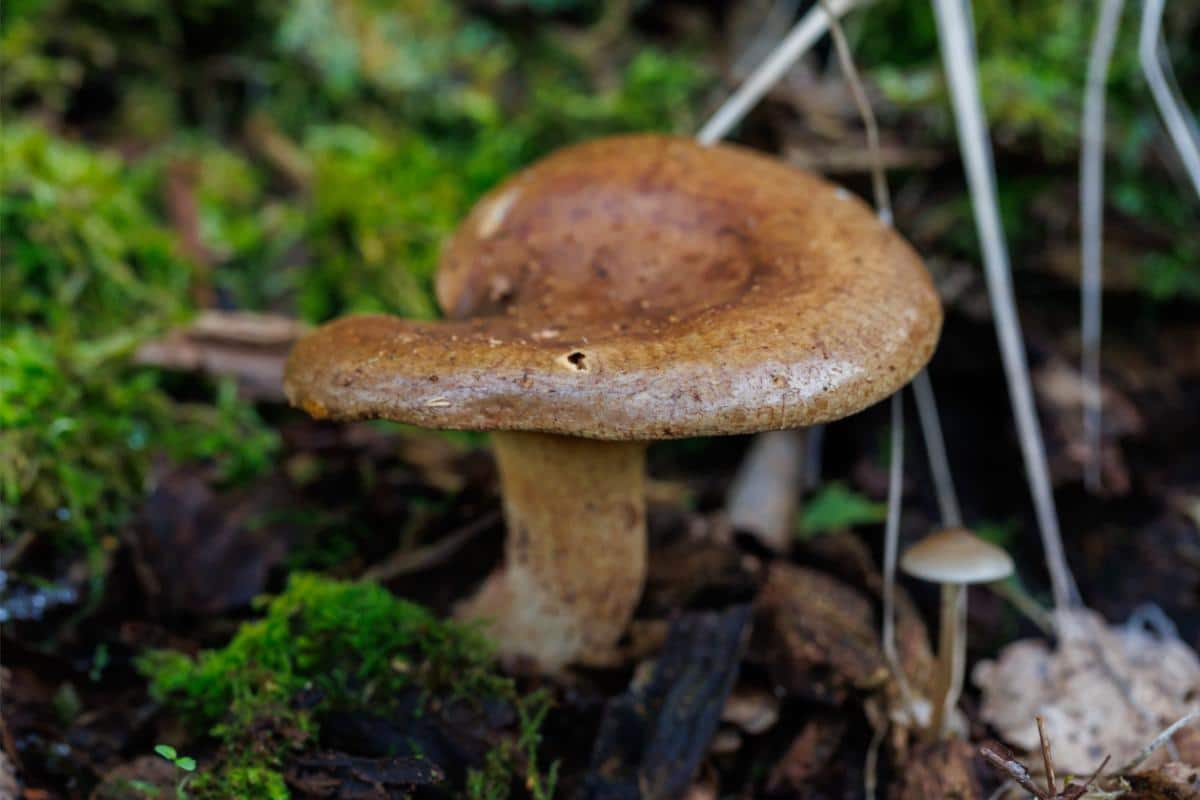
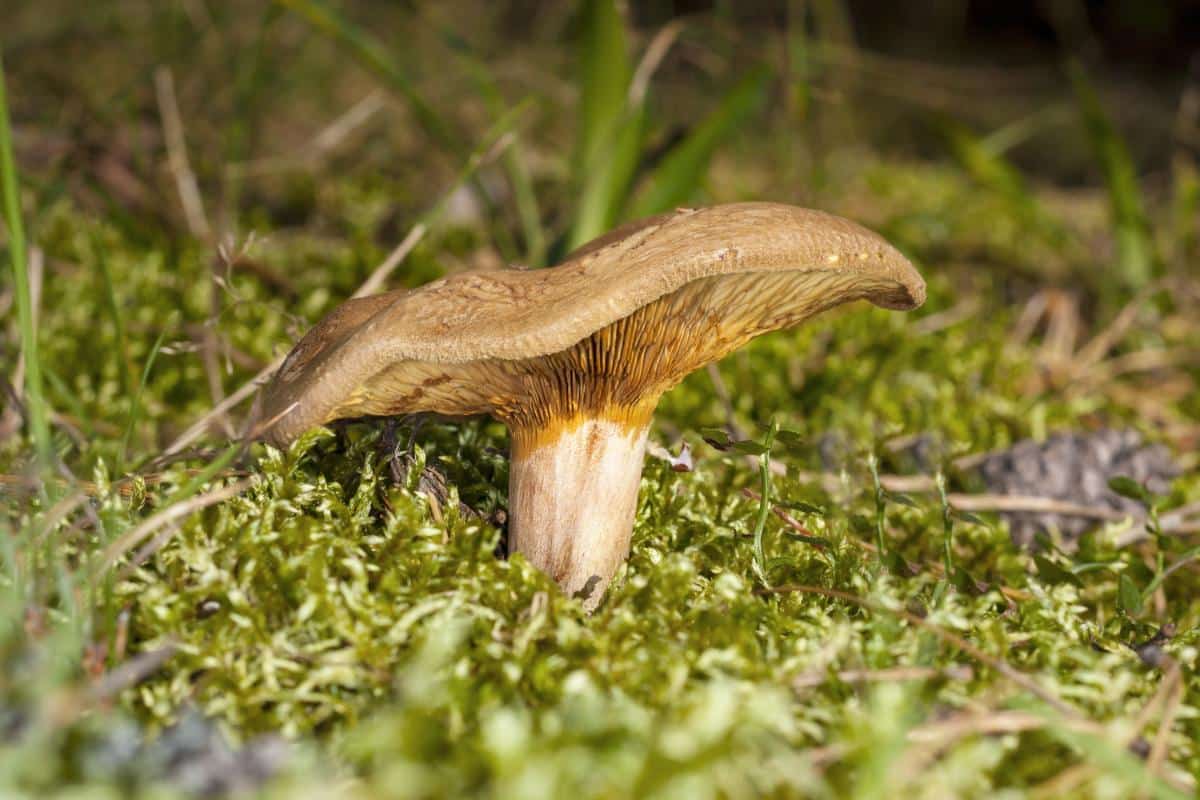
Brown Roll Rim Mushroom Identification Guide
Season
Brown roll rim mushrooms fruit in late summer and fall. The Pacific Northwest has them from late fall until mid-winter. California has two distinct types: a regular autumn version near birch trees and a larger winter version that grows with oak and pine.
Habitat
Brown roll rim mushrooms may grow alone or in scattered or dense groupings. They grow from the ground or from severely decomposed woody debris. The brown roll rim does not grow on trees or wood. They do grow in association with deciduous and coniferous trees, though. This means you often find them around these types of trees.
But they don’t limit themselves to just one type. These mushrooms prefer birch trees (Betula species) but also grow happily with pine, spruce, and oak. This flexibility is one way the brown roll rim mushrooms are able to thrive in all types of forests.
They also adapt well to places where humans have changed the landscape. These mushrooms are often found on trails, in parks, lawns, meadows, and new garden areas. They also thrive in pine plantations, which is not their natural habitat.
Brown roll rims show up almost everywhere, but they’re most common in the Northern Hemisphere. They grow across North America, Europe, and Asia. They even grow as far north as Alaska and southwestern Greenland and appear alongside various birch species.
European varieties now grow naturally in parts of the Southern Hemisphere, including South America and Australia. These mushrooms hitched a ride with shipments from pine plantations and are now happily growing outside their natural range.
This mushroom has a remarkable tolerance to pollution and even becomes more abundant in areas where other fungi can’t survive.
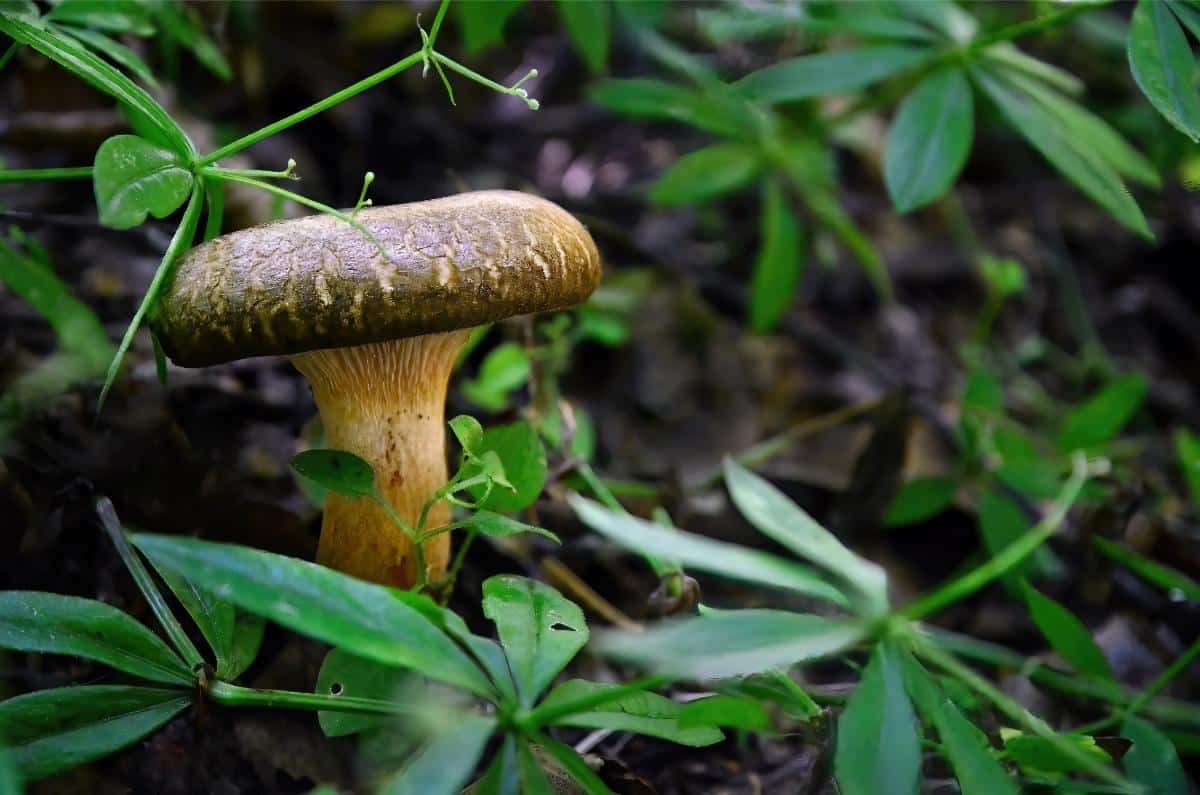
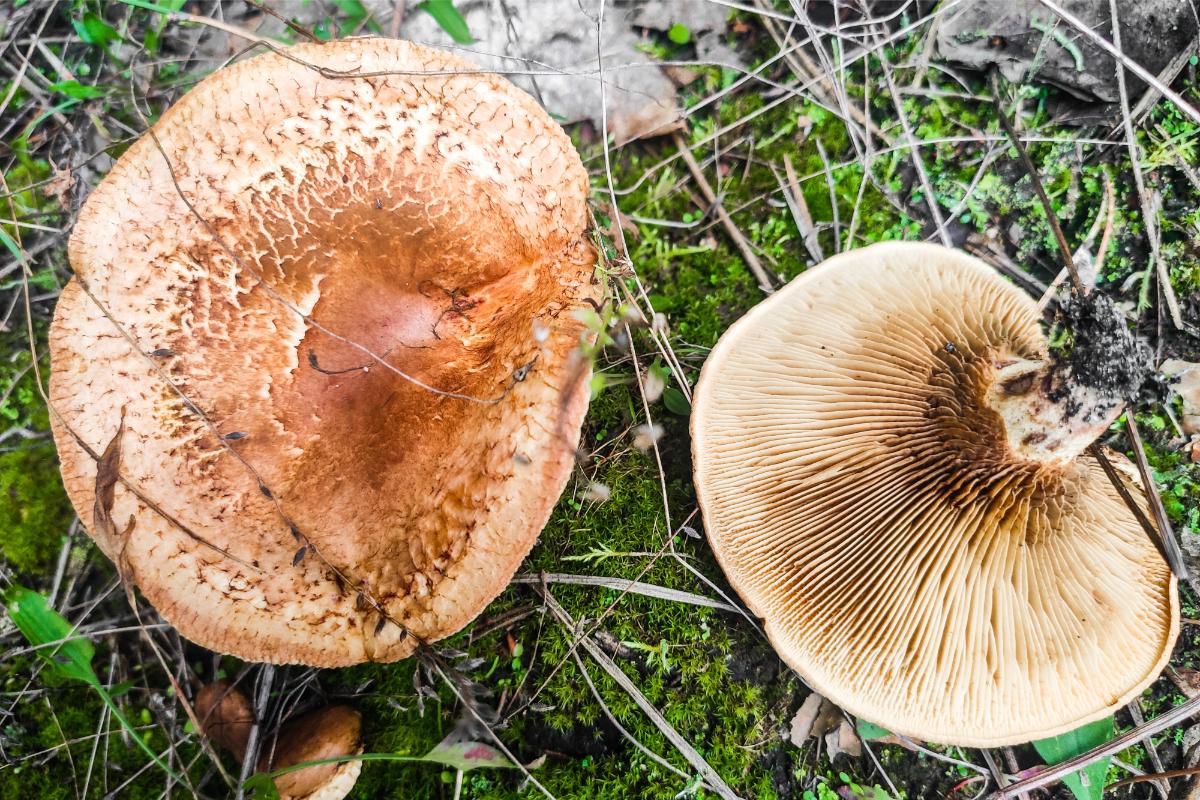
Identification
Cap
The brown roll rim’s cap starts out rounded, with a deeply rolled under edge. With age, it changes to a funnel shape with a depressed center. It usually keeps some of the rolled under edge, though, even as it grows. The young mushrooms are usually 1.5 to 4.7 inches across, while mature ones can grow to an impressive 4 to 15 inches in diameter.
The cap ranges from yellowish-brown to chestnut brown. It may have olive tints due to the environment and age. Young caps feel like suede or have a downy texture. This fuzziness smooths out as the mushroom ages. The cap surface gets sticky during wet weather. Dark orange or brown blotches might also appear on the cap after rain.
Gills
The gills are decurrent, meaning they run down the stem. These gills are close together and are yellowish to pale cinnamon or olive when young. They turn rusty brown as the mushroom matures.
The gills turn brown to reddish-brown when touched or damaged. You can also peel the gills away from the cap flesh as a layer, just like the pores of a bolete.
Stem
The stem of the brown roll rim is 2-8 inches long and up to 2 inches thick, giving it a very chunky appearance overall. It gets thinner toward the base, and the color matches the cap, but might look a bit lighter.
The stem behaves like the gills—it darkens to brownish or reddish-brown when you handle or cut it. Some mushrooms might have streaks running lengthwise down the stem or feel fuzzy near the base.
Odor and Taste
The mushroom has a mild smell that can become musty or fragrant as it ages. The taste is often sour or acidic.
Flesh color and Staining
The flesh of the young brown roll rim mushroom is thick, firm, and yellowish in color. The flesh changes color when cut or exposed to air—it turns brown. This color change happens slowly; it starts lighter and then turns brownish.
Spore Print
The spore print is purplish-brown to yellow-brown, and some people refer to it as “burnt orange” or “clay brown.”
Bolete Eater Infection
Sometimes, this mushroom gets infected by Hypomyces chrysospermus, also known as the bolete eater, which is a type of mold that lives on Boletales mushrooms. When infected, a white powder initially appears on the pores. Then it spreads across the mushroom’s surface, changing from a golden yellow to a reddish-brown as it matures.
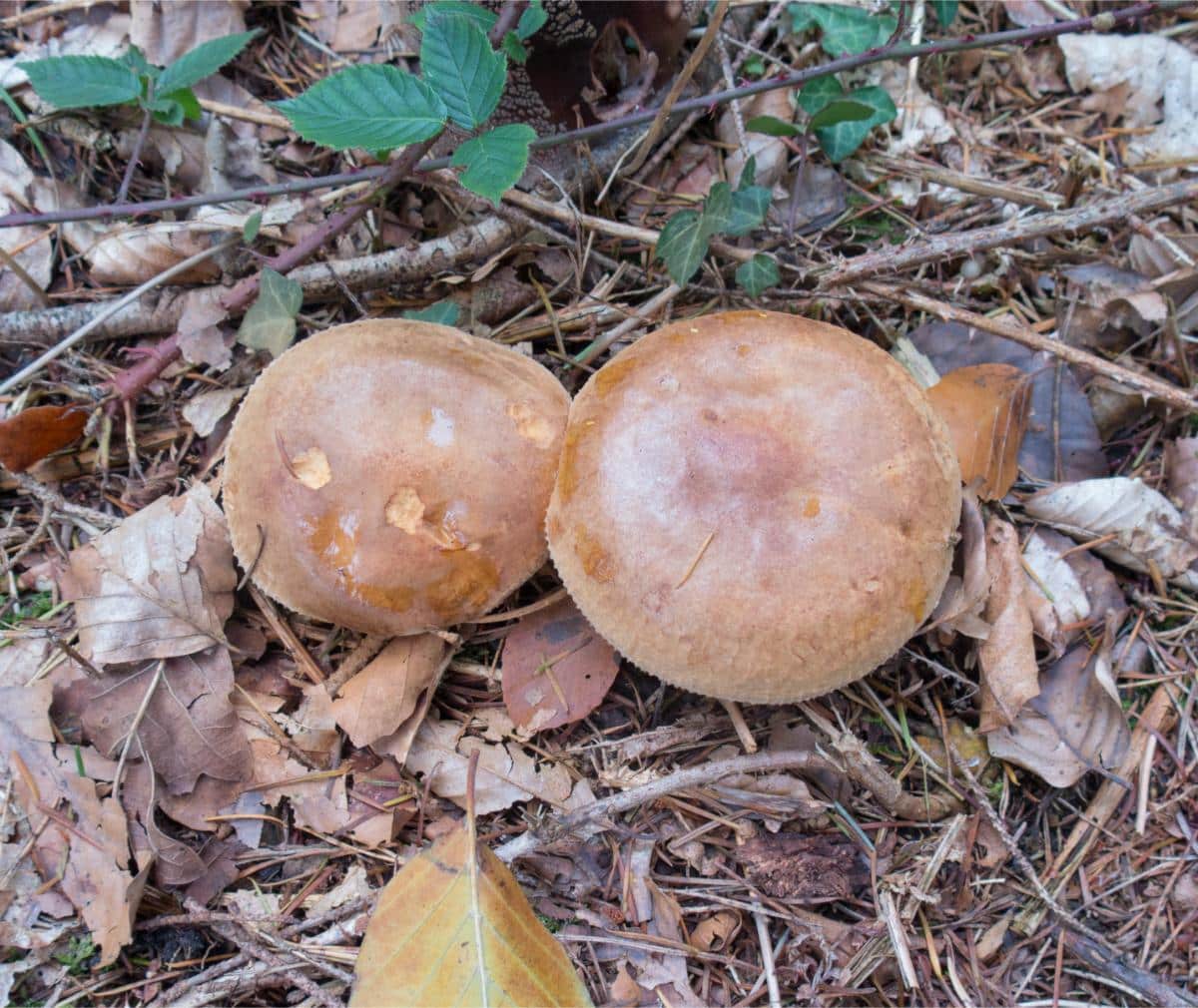
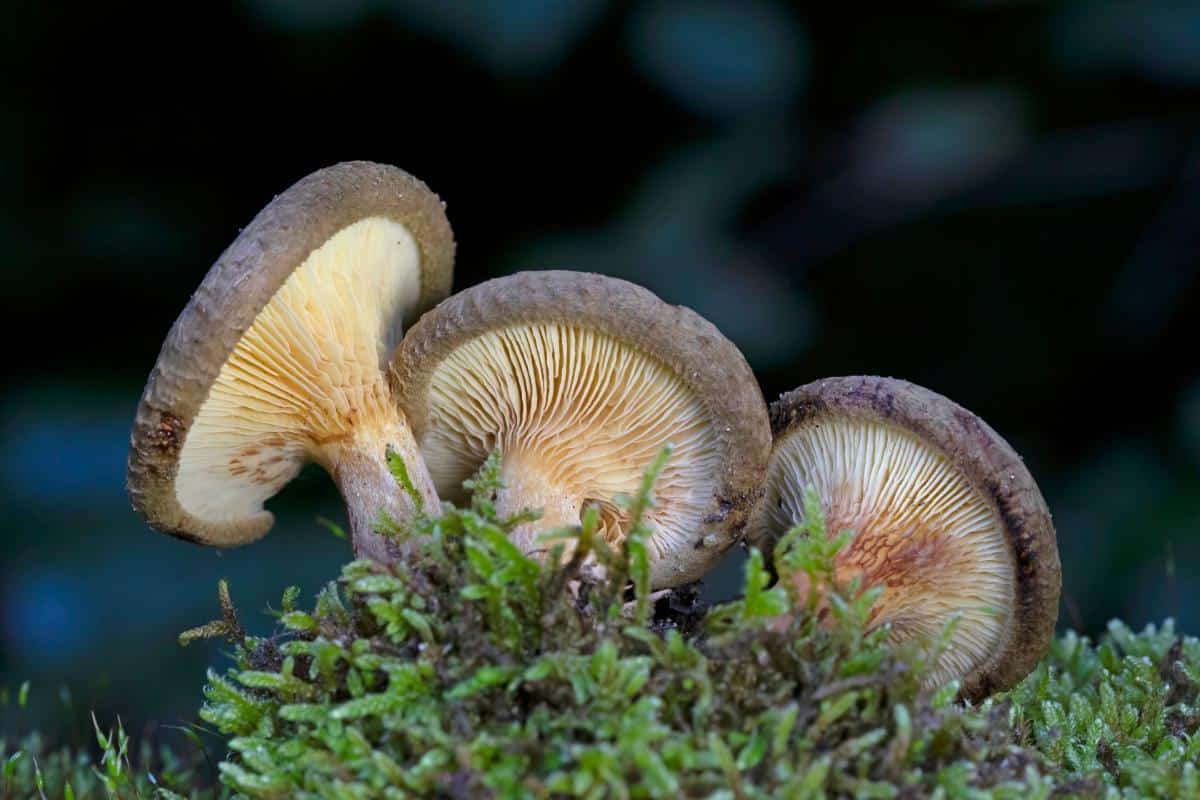
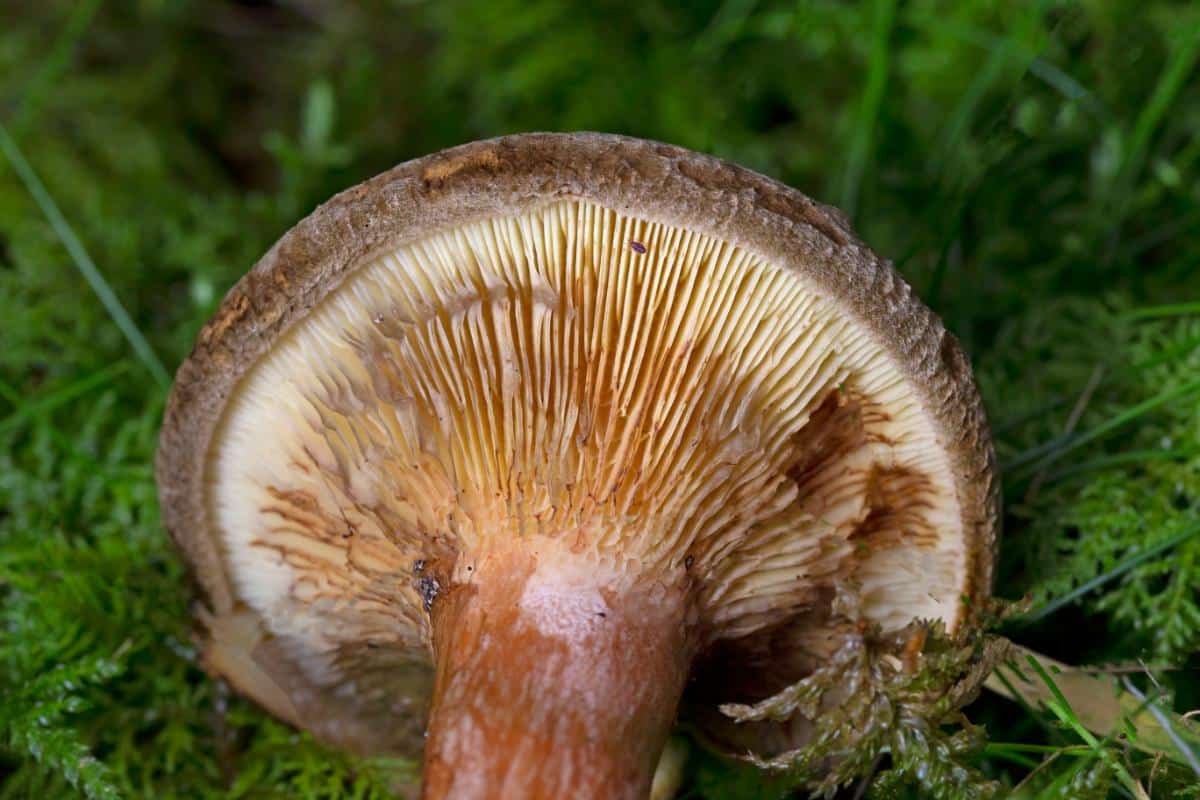
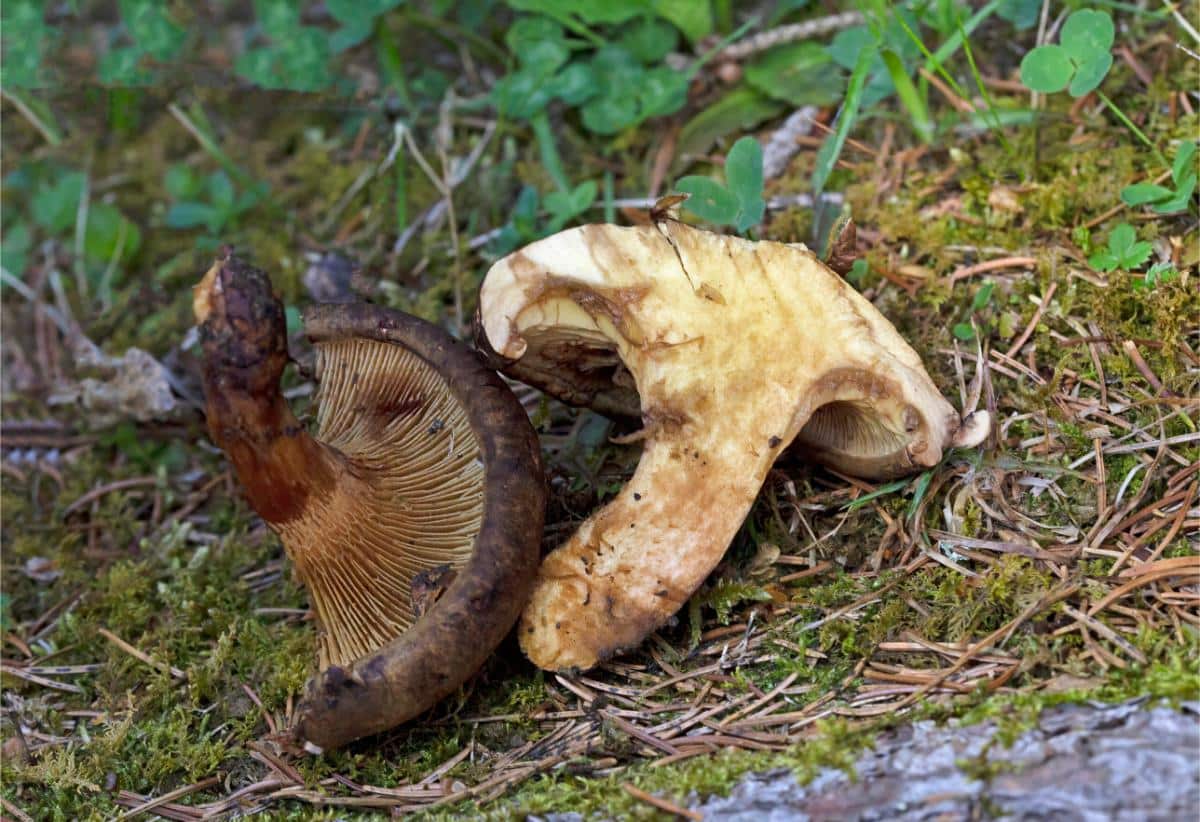
Toxicity and Health Risks of Brown Roll Rim Fungus
People across Central and Eastern Europe ate brown roll rim mushrooms regularly until World War II. Polish communities would often pickle or salt these mushrooms as a common practice. The foragers knew that the raw mushrooms caused stomach problems, but they believed that cooking made them safe. Some regions still eat this fungus despite its proven dangers. Each year, fatal poisonings occur in Poland, Russia, and Ukraine. Medical records indicate at least 14 severe cases over the past few decades. Six of these cases proved fatal.
German mycologist Julius Schäffer’s death in October 1944 was a catalyst for change in our understanding of brown roll rim toxicity. He ate the mushroom and developed severe symptoms within an hour. This was not his first time eating the mushrooms; he’d eaten them many times without issues. However, this time his kidneys failed, and he died 17 days later.
Despite the risk of death, it wasn’t until 1990 that guidebooks clearly warned against eating P. involutus, and one Italian guidebook even suggested it as late as 1998. Many people over decades have been eating these mushrooms (and still do) and have no symptoms or issues, at all. These folks would see no reason to stop eating the mushrooms, and they are still very much eaten around the world, especially in Eastern Europe.
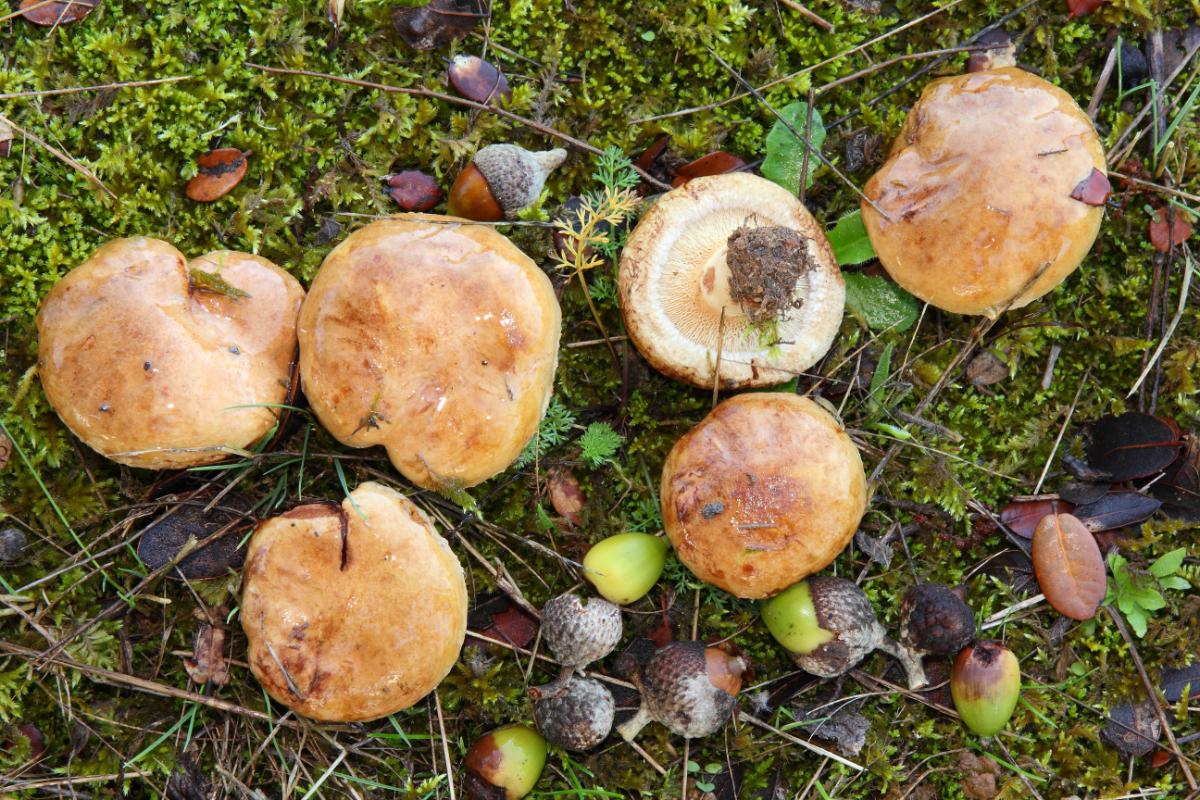
The syndrome itself seems to be quite rare and happens after eating Paxillus mushrooms repeatedly. It seems you can eat them just fine, until you can’t and then they might kill you without warning. This makes it a very tricky and deceptive species! Some recent research suggests that people with preexisting conditions are the most at risk. However, this is also super tricky. If you’ve been eating the mushrooms for 10+ years with no issues and then develop a condition (like Hep C), the next time you eat the mushrooms could the last. This still needs to be studied.
Paxillus syndrome usually occurs when someone has eaten the mushroom for a long time, sometimes for many years, and has had mild stomach issues before. The Paxillus syndrome is better understood as a hypersensitivity reaction rather than a toxic reaction. It is caused not by a true poison but by the antigen in the mushroom.
Brown roll rim poisoning shows up in two distinct ways. The first reaction happens within 1-2 hours of eating the mushrooms. The symptoms are nausea, vomiting, diarrhea, and stomach pain. This is often it, and the only thing someone might experience.
The second, more dangerous “Paxillus syndrome” develops after people eat these mushrooms repeatedly over months or years or decades. This severe reaction starts with stomach issues and leads to hemolysis, kidney failure, shock, jaundice, and possibly disseminated intravascular coagulation. There is no antidote or cure for Paxillus syndrome.
Paxillus syndrome occurs when mushroom antigens trigger the formation of antibodies in the blood. These antigen-antibody complexes adhere to the surfaces of red blood cells and destroy them. People rarely have this reaction the first time they eat the mushrooms, or even the second or third. The problem develops after repeated exposure. Heat from cooking doesn’t destroy these dangerous compounds.
Doctors focus on supportive care for brown roll rim poisoning. They monitor blood count, kidney function, blood pressure, and electrolyte levels. Patients with kidney failure need dialysis.
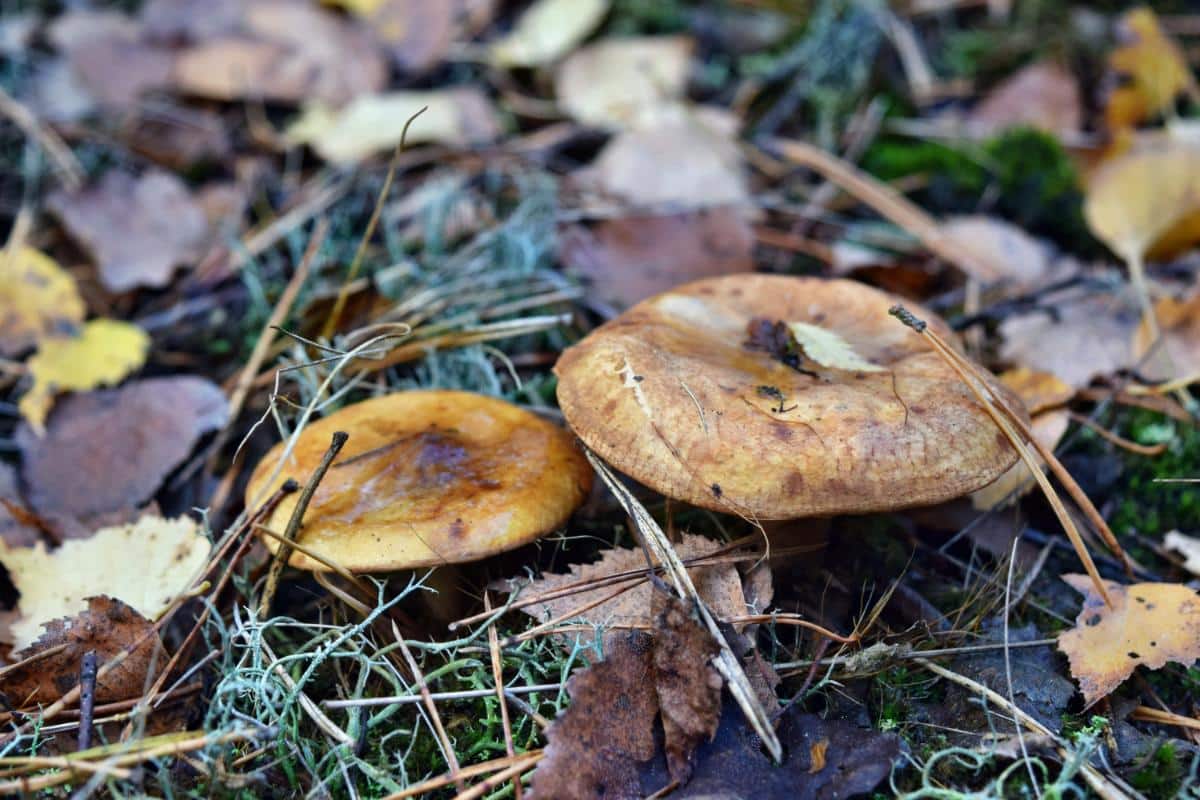
Brown Roll Rim Mushroom Lookalikes
Velvet Roll-Rim (Tapinella atrotomentosa)
The velvet roll-rim was previously classified as Paxillus atrotomentosus and was thought to be in the same family as the brown roll-rim. However, while it is still related and in the Boletales order, it is not as closely related as once thought.
The velvet roll rim looks exactly like the brown roll rim, except it has a very velvety cap and velvety stem. When they are both young, and the brown roll rim has some fuzziness on it, they can easily be mistaken. The velvet roll rim, though, is much fuzzier than the brown roll rim, overall.
There is another key feature that sets them apart as well. The velvet roll rim grows on wood, especially conifer stumps. This is in direct contrast to the brown roll rim mushroom, which grows from the ground.
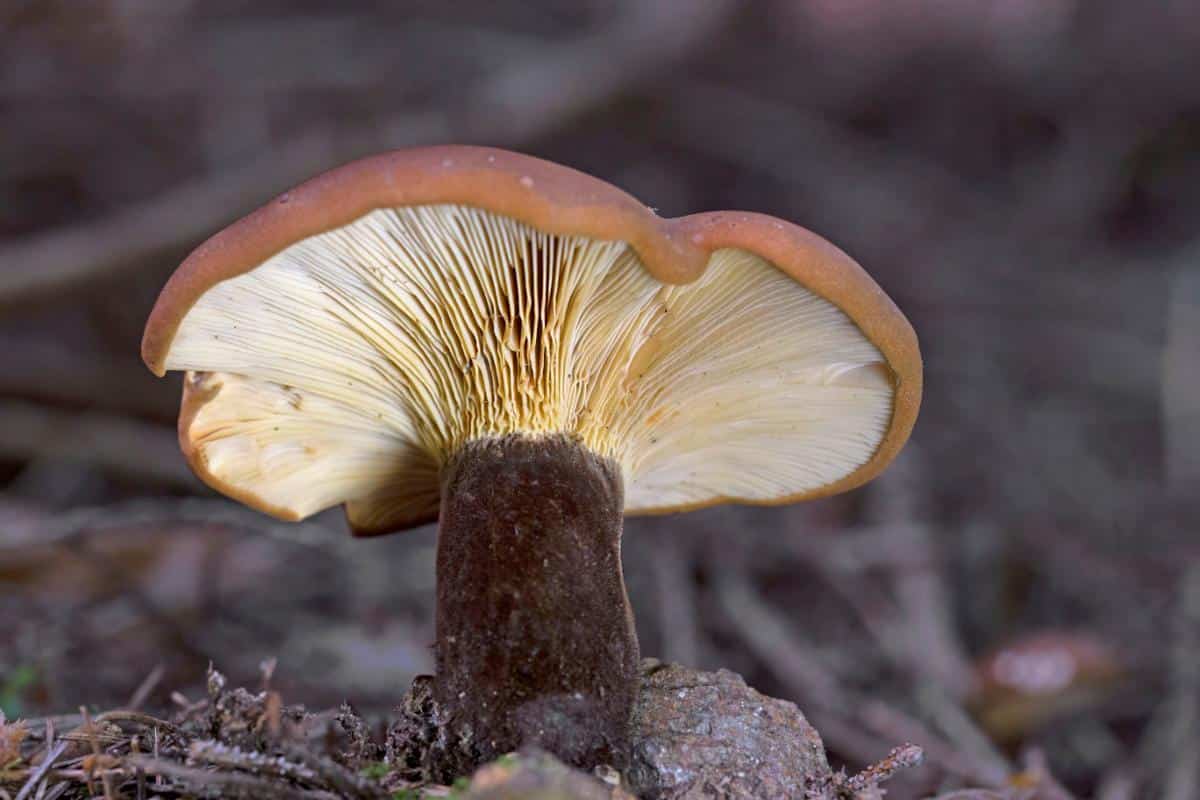
Alder Roll Rim (Paxillus filamentosus)
This species is much less common than the brown roll-rim. It looks extremely similar, but only grows with alder trees and is not nearly as widespread or opportunistic as the brown roll rim mushroom.
Paxillus vernalis
This related species also looks pretty much identical to the brown roll rim. However, it only grows with quaking aspen and paper birch trees. It usually grows on the ground but may also grow on wood.
Milky Cap Mushrooms
Many Lactarius species (also known as milky caps) may resemble the brown roll rim due to their bland to brownish colors and funnel-like shape. There is an easy way to tell them apart, though. Milky cap mushrooms bleed a milky latex when you cut their gills. Often, they’ll also “bleed” when you cut or snap the stem, too. Brown roll rim mushrooms do not do this. You might see staining on the gills of the brown roll rim that looks like the remnants of milky bleeding. However, the staining on the roll rim is from being handled.
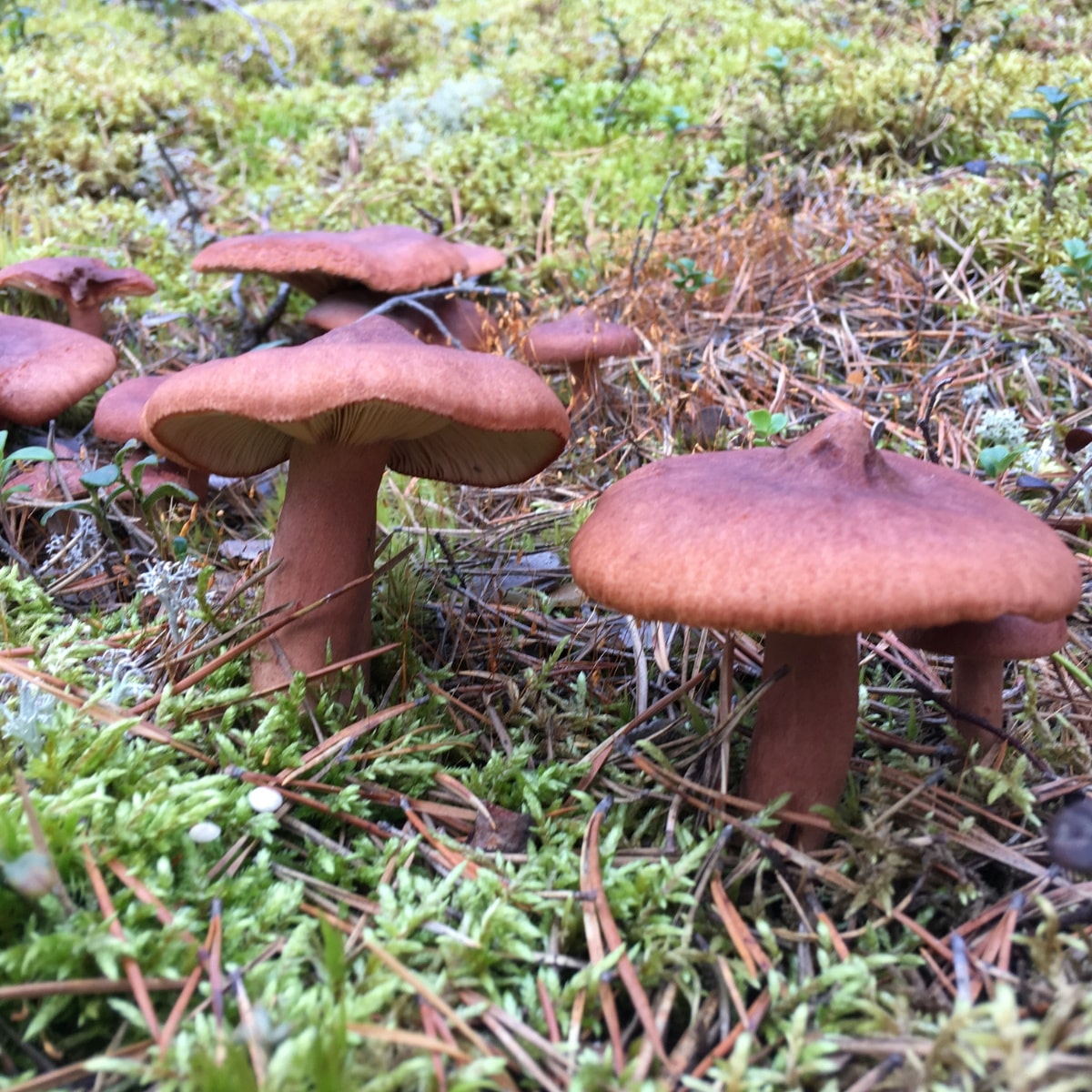
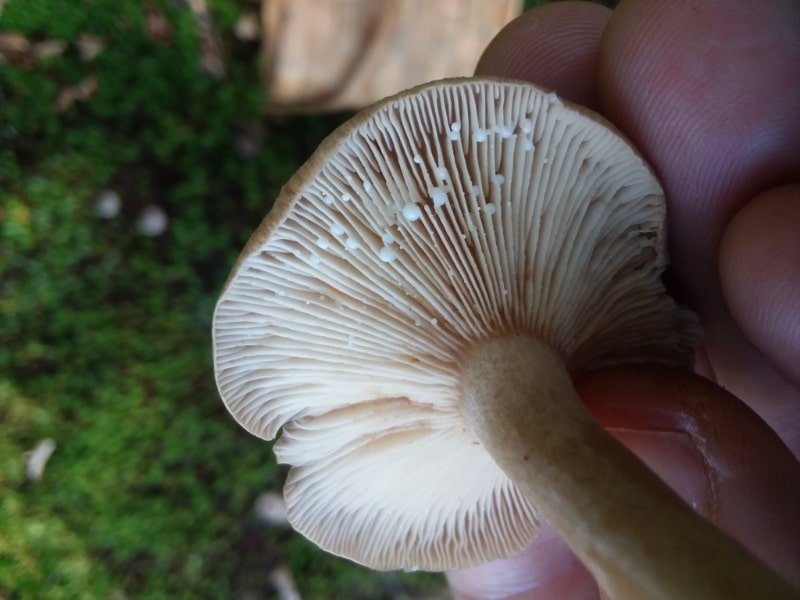
Gilled Boletes (Phylloporus sp.)
The gilled boletes belong to the same Boletales order as Paxillus and look quite similar in many cases. They tend to be stout, somewhat peg-shaped, and have gills that peel away easily from the cap. To tell them apart, look for fuzziness on the cap and stem, staining on the gills, and differences in cap and gill colors. These are usually enough to differentiate the brown roll rim mushroom from various gilled polypores.
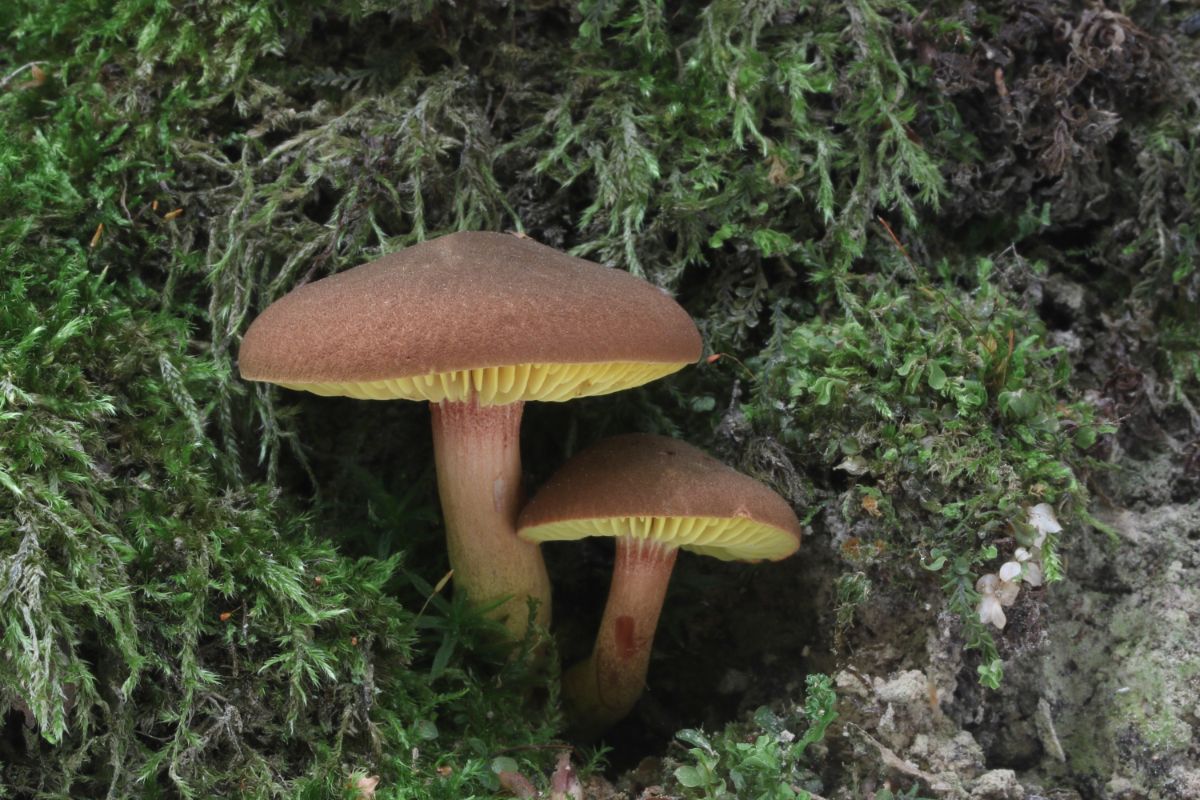
Brown Roll Rim Mushroom Ecological Role
Because the fungus has generalized nutrient needs and can grow with many types of trees, it is often used in research and seedling inoculation programs. There is proof that this is good for trees. In one study, P. involutus was grown on the roots of red pine (Pinus resinosa), and the roots showed much better resistance to harmful types of the common soil fungus Fusarium oxysporum. Seedlings treated with P. involutus also showed better resistance to Fusarium. It also was beneficial to seedlings during times of drought.
This means the brown roll rim mushroom might be making antifungal substances that protect the host plants from root rot. Paxillus involutus also helps reduce the absorption of some harmful elements. It acts as a shield against heavy metal damage in the host tree. For example, the fungus reduced the harmful effects of cadmium and zinc on Scots pine (Pinus sylvestris) seedlings. This happened even though cadmium itself stops ectomycorrhiza formation in seedlings. But, since P. involutus lowers the movement of cadmium and zinc to the tree’s upper parts and changes the balance of zinc going to the roots and upper parts, more cadmium is being kept in the roots instead of spreading throughout the plant.
A study of a polluted Scots pine forest near Oulu in northern Finland found that P. involutus grew more abundantly in areas with higher pollution levels, while other species decreased in abundance. Pollution came from pulp mills, fertilizers, heating, and traffic, which was measured by sulfur levels in the pine needles.
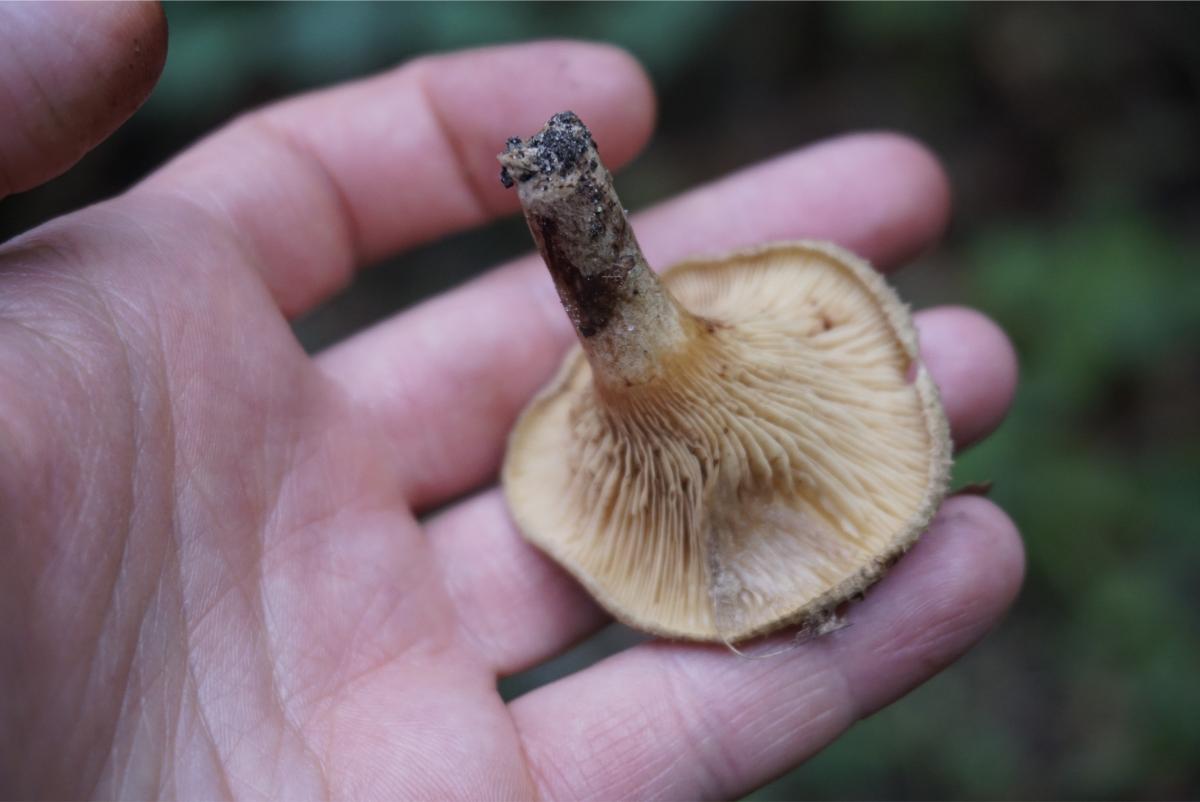
Medical potential of Paxillus involutus
Research shows that this mushroom contains bioactive compounds, including phenolics and flavonoids. These compounds give it high antioxidant, antimicrobial, and antibiofilm activities. This mushroom has shown particularly strong effects against resistant strains of E. coli. It also might have potential in cancer treatment – methanolic extracts have shown selective cytotoxicity against colon cancer cells.
This mushroom also has novel hypoglycemic compounds that could be useful for diabetes management. A big benefit of these compounds is their ability to reduce postprandial blood glucose levels with potentially fewer side effects than current medications. Traditional inhibitors can cause unpleasant gastrointestinal side effects with long-term use; however, these natural compounds may offer a more tolerable alternative.
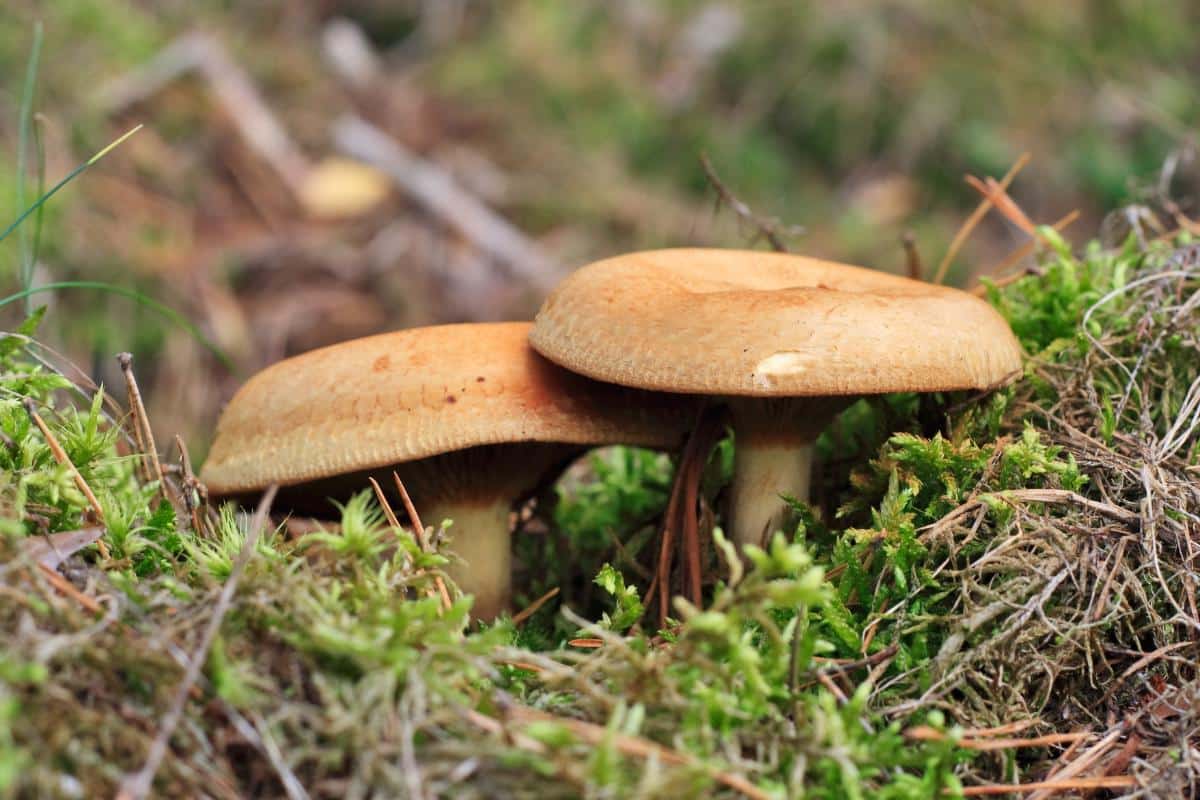
Common Questions About The Brown Roll Rim Mushroom
Is the brown roll rim mushroom safe to eat?
No. We do not recommend eating the brown roll rim mushroom. Despite being considered edible in the past, it contains compounds that can cause severe autoimmune reactions, potentially leading to death. These toxins are cumulative and usually appear after years or decades of eating the mushrooms.
Where are brown roll rim mushrooms commonly found?
Brown roll rims are widely distributed across northern forests, as well as urban and suburban areas. They form mycorrhizal relationships with various trees, particularly birch, and prefer acidic soils. They can also be found in some regions of the Southern Hemisphere, where European trees have been introduced.
What are the symptoms of brown roll rim mushroom poisoning?
Many people have no symptoms the first time or even many times after eating brown roll rim mushrooms. Allergic symptoms may include gastrointestinal distress within 1-2 hours of consumption, such as nausea, vomiting, and abdominal pain. In severe cases, when the mushroom has been eaten for years or decades (repeated consumption), it can cause sudden hemolysis, kidney failure, and potentially fatal complications.
Are there any mushrooms that resemble the brown roll rim?
Yes, several mushrooms resemble the brown roll rim, including the velvet roll-rim (Tapinella atrotomentosa), certain milk cap species (Lactarius), and Paxillus filamentosus. However, these lookalikes have distinct characteristics that set them apart, such as growth habitat or the presence of milky latex when damaged.





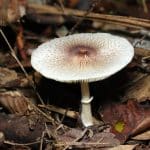
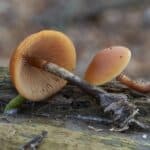


Leave a Reply